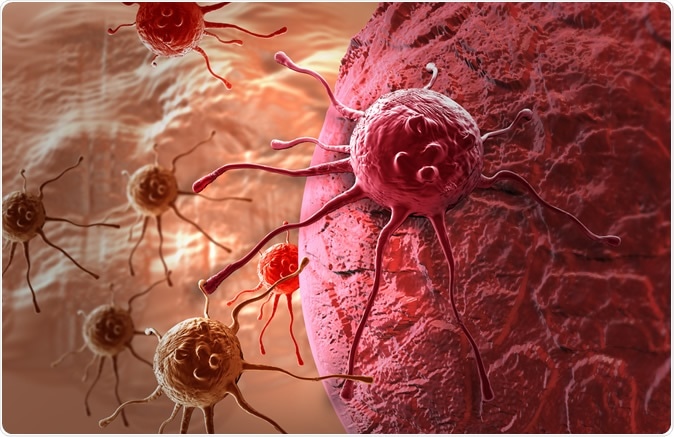A new study shows that targeting a specific protein found within quickly spreading high-grade serous carcinomas (HGSC) of the ovary could help contain these cancers. HGSC is the most common and deadly form of epithelial ovarian cancer, which is itself the deadliest cancer of the female reproductive tract. When HGSC spreads outside the ovaries, within the peritoneal cavity, it forms detached balls called spheroids, which may look and act differently from the adherent cells of the primary tumor.
The study is published in the current issue of the journal Molecular Cancer Research.

Cancer cell Illustration. Image Credit: Jovan Vitanovski / Shutterstock
70% of HGSC relapse despite treatment, becoming resistant to chemotherapy, which makes the new discovery a true potential breakthrough in the treatment of this tumor.
All life at cellular and organism level depends upon thousands of life processes that provide and degrade a range of chemicals required for proper function of the cells and tissues. These intricately interdependent processes together they make up the body’s metabolism.
However, as researcher Erika Dahl explains, “A hallmark of cancer cells is that their metabolic processes are often different from normal, healthy cells.” This is called metabolic reprogramming. As one of the outcomes, study author Katherine Aird says, “Cancer cells can grow forever without stimulus.”
The good news about the newly discovered protein is that it can be inhibited, thus inactivating cell processes within ovarian cancer cells to switch them from a constitutively proliferative cell cycle to one which results in senescence, or going to sleep. The key role of the protein was identified on cell culture experiments by researchers at Penn State College of Medicine.
The current study focused on teasing out the differences in the metabolism of ovarian cancer cells by comparing them with cells from a normal fallopian tube.
The route used to achieve this was quantitative spectrometry, which helped analyze the metabolites produced by various cellular pathways in the two type of tissue. Among the differences, it was revealed that cancer cells utilized glucose, a form of sugar, via the key energy cycle called the citric acid cycle, far more often, as against the more common use of an oxygen-requiring pathway called aerobic glycolysis. This accounts for the presence of a high level of citric acid activity in all high-grade serous ovarian cancer cells.
This means that many therapies which inhibit the breakdown of glucose (glycolysis) to destroy cancer cells may be quite ineffective. Dahl commented that this could often result, in fact, in the production of toxins that harm normal healthy tissue.
Instead, the team in the current study looked at the effects of inhibiting the wildtype or normal form of an enzyme, isocitrate dehydrogenase 1 (IDH 1), which plays a vital part in the citric acid cycle. They selected this protein because it was the only one in this pathway that is expressed at higher levels in both adherent and spheroid tumor cells. Increased activity of this enzyme severely impacts progression-free survival, which is an important outcome measured in assessing the effectiveness of any cancer therapy.
Mutants of this protein are common in other tumors, but the wildtype form is typically present in cells within HGSC. The researchers hypothesize that the presence of this enzyme is an important advantage to these cells, and its inhibition is a key step to inducing senescence.
The researchers found that suppressing the work of this protein stopped cell division completely by suppressing the activity of multiple other genes, inhibiting vital metabolic pathways. Both adherent cells of the primary tumor, and spheroid cells of secondary HGSC, become senescent when the wildtype IDH 1 enzyme is inhibited. Thus, this could be an excellent way to treat HGSC at all stages. This is an important consideration, as ovarian cancers are rarely diagnosed at early stages.
While there are already FDA (US Food and Drug Administration)-approved drugs against one of the mutant forms of this enzyme, the team wondered whether they would work against the wildtype form as well. They found that one did, and this is now a part of their continued research agenda.
Aird says, “One of our long-term goals is to try and repurpose this already-approved drug as a treatment for this form of ovarian cancer.” Besides adapting existing drugs against the enzyme to fight this type of cancer, the researchers want to examine the differences in the metabolic functioning of normal and HGSC cells more closely. Another goal is to examine the effectiveness of combining IDH 1 inhibitors with other treatments.
Journal reference:
Targeting IDH1 as a Prosenescent Therapy in High-grade Serous Ovarian Cancer, Erika S. Dahl, Raquel Buj, Kelly E. Leon, Jordan M. Newell, Yuka Imamura, Benjamin G. Bitler, Nathaniel W. Snyder and Katherine M. Aird, Mol Cancer Res June 17 2019 DOI: 10.1158/1541-7786.MCR-18-1233, http://mcr.aacrjournals.org/content/early/2019/06/17/1541-7786.MCR-18-1233